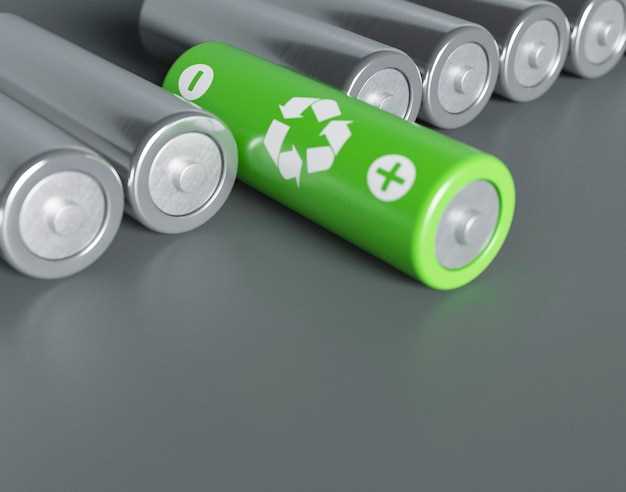Recommendation: Start now by mandating a domestic recovery program for key metals from spent energy-storage modules; this makes supply predictable over the next period and reduces exposure to external shocks. At the first stage, establish standardized intake channels, separate processing streams, and report recovered yields in real time to policymakers and producers.
Below the bottom-up echelon, post-processing lines separate nickel, cobalt, manganese and lithium compounds; the recovered fractions feed producer-grade inputs, while slag by-products support cement and construction uses, improving economics as their value rises. This reduces virgin feedstock needs in the extended term and creates a scenario where local channels feed applications across electronics and mobility segments.
Currently, policy makers and industry players in the region are expanding second-life programs; already, pilots show that a share of processed outputs can re-enter the supply chain, potentially reaching double-digit levels if scale is achieved. By integrating closed-loop flows, a fuller rise in recovered inputs is possible, while policy support remains in place through a predictable period.
Point of action: launch coordinated pilots that collect modules from consumer and fleet segments, before disposal, and route them to nearby separation facilities; link bottom-up data with central dashboards to monitor applications and end-use demand. Structured scenarios help producers plan capacity, reduce risk, and keep slag streams under control for secondary markets.
In the long run, a robust recovery stream shifts the strategic risk from a single producer’s decisions to a diversified network of collectors, processors and applications; this supports a resilient scenario for all players, including smaller producers and end markets, while keeping below-peak price moves in check.
Practical angles on recycling workflows, material recovery, and cost dynamics for policymakers, manufacturers, and researchers
Recommendation: establish a top-down mass-flow model facing the entire chain to align inputs, collection, and reuse with policy levers, anchored to fixed cost insights and annual targets.
Map modules by composition and content, segment streams by sectors, and define a fixed lifespan for each cohort; specify the required collection rate to meet annual targets and reduce losses in mixed streams.
Cost dynamics hinge on energy intensity, chemical routes, and throughput; the implications for policymakers include mandating reporting of mass balance, energy use, and the assumed share of content recoverable; this informs investors and industry about true payback periods.
Hydrometallurgy can be anchored to feedstocks with varied chemistry, enabling selective dissolution to recover metals; design should consider the content of cathodes and anodes and the mass balance across streams; a fixed assumption on impurity tolerance will influence equipment sizing and waste handling.
Pilot programs in Hungary can compare cost curves between direct reuse of modules vs secondary processing; capture annual savings from reduced input losses, and demonstrate meeting national targets with a lean bill of inputs; investors will follow a clear technology roadmap that shows capex, opex, and payback under different demand-supply scenarios.
In the near term, a crunch in inputs can tighten margins; policy can smooth this by establishing shared standards for reporting content, ensuring transparent inputs and fixed collection rates; this reduces volatility and improves planning for sectors with high demand for critical metals.
Establish a centralized content database with simulated scenarios to test expansion under expanding markets; include modules on collection cost, transportation mass, and processing throughput, plus an annual update of required inputs and performance indicators.
For policymakers, adopt a phased meeting of milestones: 1) measurement of mass and composition at source, 2) validation of hydrometallurgy-without-waste options, 3) transparent reporting on content and potential reuse; for manufacturers, implement modular processing lines and standardized chemistries to minimize fixed costs and boost scalability; for researchers, focus on chemistry optimization and lifecycle assessment to quantify implications across sectors.
What material recovery potential can current Li-ion recycling methods achieve across major chemistries?

Recommendation: Focus on established, chemistries-tuned recovery lines that combine mechanical disassembly with selective hydrometallurgy to unlock valuable metals and extending the life of supply chains, facing challenges with feedstock variability while pursuing substantially lower costs and upstream dependency reduction; align with emerging standards to lead the market and set a goal for cost and purity targets.
Numbers from current practice across major chemistries show the potential to recover approximately 85-95% of cobalt, 90-98% of nickel, and 60-75% of lithium under optimized flows, with manganese recovery frequently exceeding 85%. These figures depend on input quality and process integration, but they underscore a substantial improvement relative to historical performance.
Asia and Europe are the hotbeds of progress. In korea and broader asian economies, policy support and industry collaboration are extending established flows, while many european initiatives push standardization and traceability, tightening a gate between collection and refining that improves process economics.
Challenges include feedstock heterogeneity, impurities, and data gaps that hinder consistent outcomes. Upstream collection logistics and cross-border data sharing are critical to maintaining a stable situation, with many players seeking standardized procedures that can be scaled to international contexts.
The combination of established practices and emerging innovations can deliver co-benefits that address climate-change pressures and supply risk. Their goal, across korea, asia, and europe, is to reduce external dependence and create a reliable, local value chain for high-demand chemistries, tied to robust data and cross-border collaboration. articles from leading institutes underline the numbers and provide a roadmap for scale, emphasizing upstream reduction, gate-level coordination, and sustained focus on efficiency.
Which processing routes–mechanical shredding, hydrometallurgy, or pyrometallurgy–drive the most favorable cost profiles?
Hydrometallurgy delivers the most favorable cost profile on a life-cycle basis. In focused simulation runs that vary chemistries, density, and feedstreams, the resulting unit cost for recovered metals is lowest when cobalt, nickel, and manganese contents are above baseline, and when hydro-to-cathode steps are integrated early in the flow. This pathway reduces energy per unit of value and enables tighter control of chemical consumption.
- Capital expenditure: shredding lines are cheap to install, but downstream leach-and-separate trains add capex; economies of scale across two-phase plants compress unit costs and improve return times.
- Operating expense: chemical charges and electricity dominate, yet energy intensity per kilogram of recovered content is lower with hydrometallurgy than with pyrometallurgy, especially under climate-conscious grids and smarter heat integration.
- Recovery and purity: coupling hydro-to-cathode steps with selective precipitation or ion-exchange raises purity and enables reuse of high-value fractions, reducing post-treatment needs and improving yield consistency.
- Throughput and bottlenecks: shredders provide mass reduction but can bottleneck downstream leaching; workflows that move quickly from mechanical reduction to hydrometallurgy show resilience to overcapacity patterns in European and global markets.
- Enviro impact and density: emissions and residue management are more predictable with hydrometallurgy, aligning with tighter environmental rules and helping suppliers retain confidence in feedstock quality and content.
Pyrometallurgy remains attractive when feedstreams contain metals difficult to dissolve or when existing smelting capacity is underutilized; however, high energy requirements and carbon-intensity push its price profile upward unless there is favorable energy pricing or byproduct credits. In two-tier pricing scenarios, the gap between pyrometallurgy and hydro-to-cathode pathways widens as energy costs rise or chemical costs fall, making the latter more resilient to market shocks.
Mechanical shredding offers the lowest upfront cost and fastest ramp, but its limited selective recovery often necessitates downstream hydrometallurgy or pyrometallurgy to reclaim high-value fractions. In times of overcapacity, throughput can be maintained, yet the cost per unit of content improves only if downstream steps operate at full utilization. To retain value, operators focus on maximizing retriev from each part and designing modular flows that adapt to evolving chemistries.
The future lies in a hybrid approach: initial shredding followed by targeted hydrometallurgical flows, including hydro-to-cathode steps, to supply stable precursors while maintaining discipline on pricing. This pathway supports acquiring predictable supply and preserving reuse opportunities, especially as patterns shift across European markets and beyond. Success depends on identifying suppliers, aligning process steps, and coordinating with partners to avoid bottlenecks; the content and density of feedstreams will determine the required balance between pathways, with simulation guiding decisions and helping navigate climate-related constraints. There’s a clear focus on cost-efficient, scalable routes that can adapt to changing events and market dynamics, ensuring progress toward a sustainable, circular future for energy-storage components and their parts.
When does capital expenditure for a new recycling plant become financially justified compared with ongoing operating costs?
Capex becomes financially justified when the net present value of returns from recovered cathode constituents and related value streams outweighs the up-front investment over the project life, and the internal rate of return clears the target hurdle (typically 15–20%) under base-case assumptions.
Use a well-structured model that compares upfront costs against ongoing operations across multiple scenarios. The critical inputs are capacity utilization, energy and chemical costs, labor, and maintenance. If utilization is high and specific mixes of metals support favorable recovery economics, the case favors capital expenditure.
Revenue potential includes recovered cathode constituents from various cell chemistries, with direct channels to industrial producers prepared to accept these streams. For sodium-based cell types, the retriev rate of key constituents and slag handling implications will influence profitability, and higher retriev reduces external supply exposure.
Constrained demand, weak price signals, and potential regulatory threats pose a threat to cash flow. To hedge, pursue flexible capacity, phased investment, and standardization of input streams; maintain a plan that can meet varying targets and adjust to scenarios while pursuing incremental gains.
Strategic implications include standardization across channels to reduce friction between cars, industrial producers, and service providers, and this standardization will play a central role in cost reductions while supporting development. The chart will illustrate substantial savings when energy intensity declines and slag generation, minimizing environmental penalties, guides decisions and aligns targets.
Practical takeaways: adopt a phased, modular approach to capex, verify feedstock streams through pilots, and lock in long-term demand with producers to reduce weight on volatile prices. This approach minimizes risk, preserves optionality, and improves the likelihood that capital-intensive projects will meet substantial, multi-year targets that support overall industrial development and implications for the broader supply chain.
How can collection and reverse-logistics costs be optimized within the domestic EV value chain?

Recommendation: Consolidate regional collection hubs near intake points and deploy a unified data platform to track every retired unit from retirement to disposition. Simulated scenarios across three urban clusters indicate total collection and transport costs can be reduced by 18-24% within two to three years as volume grows and networks reach economies of scale. An established end-to-end workflow minimizes misroutes and reduces failure risk.
Spatial network design and layout optimization are central: a hub-and-spoke structure reduces travel distance, improves load factor, and minimizes idle mileage. Routing simulations with real-time capacity data cut average trip length by 12-20% in pilots; thus, dynamic scheduling and cross-docking become standard. The everbatt standard is adopted to align data and tagging across sites, enabling seamless hand-offs and better traceability.
Data governance and standardization: Following an established assessment framework, partners share intake data, disposal routes, and return volumes; thus, better estimates of reverse flows emerge. A common tagging and interface protocol reduces loss and misallocation, while shared dashboards give a clear view of performance per country and per site.
Cost structure and investments: Fixed costs for storage and handling drive savings when depots are centralized and shared. Volume growth increases the leverage of contractor rates and reduces unit handling costs. Investments in digital tracing, automated sorting at hubs, and trained staff began last year and should continue; the necessary funding is expected to be recouped within 3-5 years according to estimates.
Operational risks and mitigation: Potential failure to align with standards poses a risk; mitigation includes phased adoption, pilots in multiple sites, and a clear retirement schedule. A diversified set of disposal partners reduces dependency on a single supplier; this approach has begun and should scale across countries in the region, following a governance framework. The network layout should remain adaptable to regulatory changes and demand shifts.
Future outlook and actions: The path relies on simulations and real-world pilots to refine the model, helping governments and firms adopt the approach to accelerate growth and lower costs. As networks mature, costs per unit fall further, and the system can handle rising retirement volumes with minimal delay; thus, a scalable, data-driven, and collaborative layout is necessary to keep pace with increasing demand.
What policy levers and market conditions most affect the overall economics of battery recycling in the near term?
Recommendation: adopt a regional, policy-led framework that lowers capex, guarantees streams of inputs, and accelerates scale of processing hubs, providing a stable margin for producers. Assumption-driven projections indicate cost declines hinge on energy efficiency and labor productivity; policy design should deliver predictable economics under multiple scenarios.
Notably, the lever set encompasses regulatory, financial, and market-structure reforms that directly affect flows and revenues. Policy should combine regional EPR-like requirements with recycled-content quotas, top-down planning for hub networks, and streamlined permitting to shorten distances between sources and plants. Before scale is reached, adaptations to plant layouts and process lines will be necessary, but repeated cycles of implementation can compress the learning curve and raise the highest returns sooner.
Key policy levers include: regional mandates that tie the share of recovered constituents to end-user pricing, commercial incentives for plants that produce high-quality output, and procurement preferences that create protected demand for recovered streams. Special attention should go to cc-lfp streams and other high-value mixes; ensuring traceability from obtained inputs to finished products helps producers price risk and lowers transaction costs. American policymakers can leverage nine priority sites and nine leading firms to demonstrate scale benefits; a top-down approach can align incentives across players and avoid fragmented efforts. The issue of cost pass-through to consumers remains central, and policy should balance consumer exposure with long-run savings from domestic flows.
Market conditions near term influence profitability through mineral price trajectories, processing yields, and sales terms. Nine regional hubs, coupled with strategic partnerships among startups and established companies, can achieve economies of scale and reduce greenhouse-gas intensity of the high-value streams. The highest returns come from integrated supply chains that combine upstream sourcing, post-use separation, and reliable commercial offtake agreements. Distances between collection points and plants remain a key risk, so policy should favor closer siting and accelerated permitting. Obstacles include the complexity of feed-mraction, the issue of varying input mixes, and the need for consistent quality standards; addressing these challenges with standardized processes reduces volatility and drives longer-term growth.
| Levers | Near-term impact | Key risks / notes |
|---|---|---|
| Regional EPR-like schemes with recycled-content mandates | Stabilizes demand and improves feed quality; accelerates scale | Non-compliance, cross-border leakage, and administrative burden |
| Capital subsidies and tax credits for processing plants | Lowers capex, shortens payback; supports cc-lfp and high-value mixes | Budgetary pressure, political cycles, and potential misallocation if metrics are weak |
| Public procurement preferences and offtake guarantees | Drives commercial sales and predictable cash flows | Limited supplier diversity, dependency on policy continuity |
| Simplified permitting and siting to reduce distances | Lower logistics costs, faster time-to-start | Local resistance, zoning hurdles, and environmental permitting delays |
| Standards and data transparency for flows and quality | Improved pricing signals and risk management for producers | Data gaps, reporting overhead, and need for harmonization across regions |

 Lithium-Ion Battery Recycling Eases Material Scarcity Amid China’s EV Ambitions">
Lithium-Ion Battery Recycling Eases Material Scarcity Amid China’s EV Ambitions">
